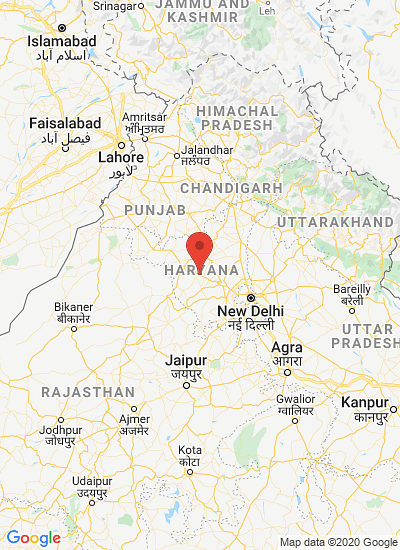A quality mark for potato seeds in India
A quality mark for seed potatoes in India
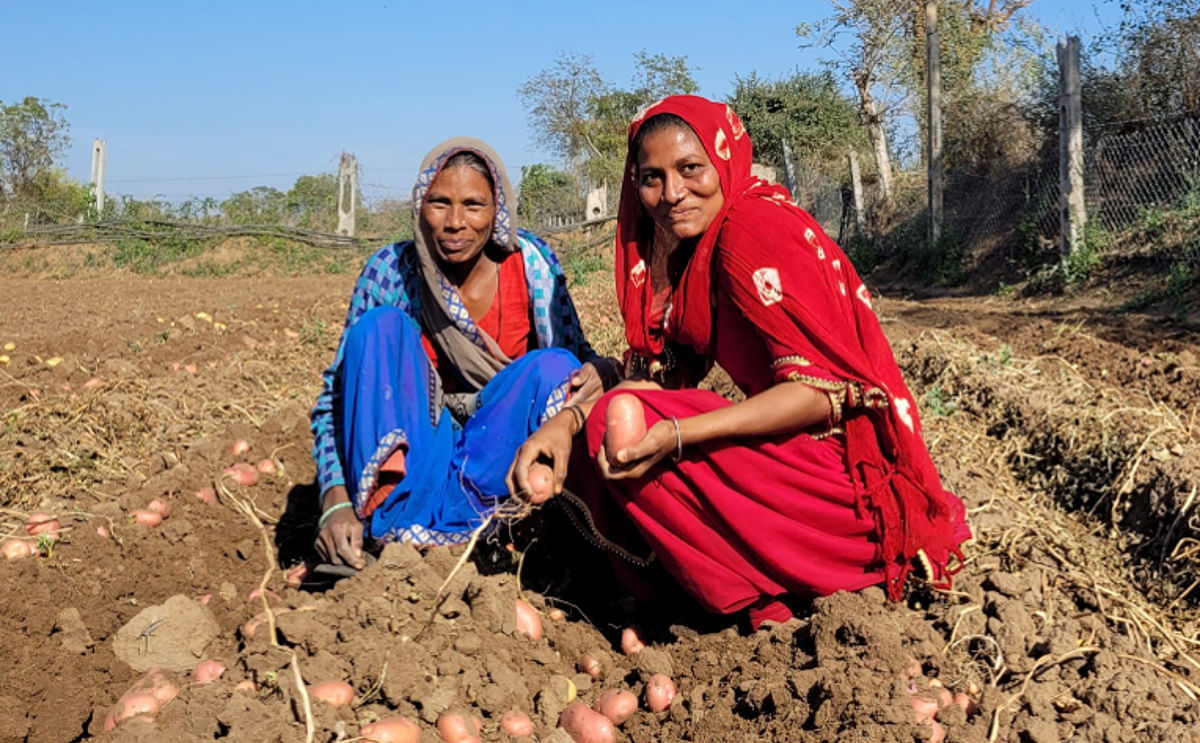
After extensive deliberations with different stakeholders including government officials, Haryana State Seed Certification Agency (HSSCA), and seed producers, the Government of Haryana with support from the CIP team launched the Har Aloo potato seed quality certification system.
Background
When it comes to human consumption, potato is the third most important food crop in India after rice and wheat and is considered a staple crop, a vegetable crop and as cash crop.
Despite more than fivefold increase in production from 8.3. million tons in 1980 to 50 million tons in 2020 and holding the rank of second-largest producer and consumer of potato, the sector continues to struggle with several constraints, in particular, lack of affordable and available quality planting material for smallholder producers.
Potato seed production system in India
Most potato seeds in India are produced using aeroponic technology by private companies. Companies buy mother cultures from the Central Potato Research Institute (CPRI) and multiply them in tissue culture laboratories, resulting in tissue culture plantlets.
The plantlets are then placed on Styrofoam sheets in growing boxes in a high-tech temperature-controlled facility and fed with nutrient solutions which are sprayed onto their roots.
The plantlets produce mini tubers which are then harvested at regular intervals and planted in open fields by both seed companies and contracted seed-producing farmers to produce first generation (G1) seeds. Once G1 seeds are produced, further multiplication up to fifth-generation seeds takes place also in open fields, often by seed-producing farmers.
The challenge: No quality guarantee
Seed companies often purchase seeds directly from farmers who in turn purchase mini tubers which they multiply in their fields. As there is currently no central quality control monitoring mechanism for seeds multiplied by farmers, those farmers who buy them lack quality guarantees. This includes seeds labelled as early generation which may or may not actually be early generation.
At the same time, each company has its own quality control monitoring mechanism which makes the situation even more challenging when it comes to quality guarantees for farmers.
As part of its Small Farmers Large Field (SFLF) group initiative – a collective action model for improving the livelihoods of small farmers in India – CIP put this to the test, facilitating the purchase of thousands of metric tons of seeds from ‘reputable’ seed companies.
The results of CIP’s examination of the ‘Truthfully-Labelled Seeds’, as they are referred to in India, revealed several instances of poor-quality seeds, including some infected with seed borne diseases.
As potato seed costs are high and account for nearly half of the total production cost, potato farmers are reluctant to invest large sums in seed purchases without quality guarantees and end up using cheap local seeds or discarded table potatoes from the local market, which in turn, results in lower yields than those from quality seeds.
The solution: Har Aloo – a quality mark for potato
CIP, in collaboration with the Potato Technology Center, at the Department of Horticulture, Government of Haryana set out to develop a potato seed quality mark to assure quality and authenticity. The goal was to develop a system that gave farmers a degree of confidence in the quality of purchased potato seeds.
The quality mark would guarantee that the potato seed originated from Haryana and meets the quality standards defined by the Government of Haryana. After extensive deliberations with different stakeholders including government officials, Haryana State Seed Certification Agency (HSSCA), and seed producers, the Government of Haryana with support from the CIP team launched the Har Aloo potato seed quality certification system.
Har Aloo is the first of its kind for potato seeds and was developed along the same lines as the green logo of Thai Hom Mali rice (Figure 1), a stamp of authenticity from Thailand’s Department of Foreign Trade and Ministry of Commerce.
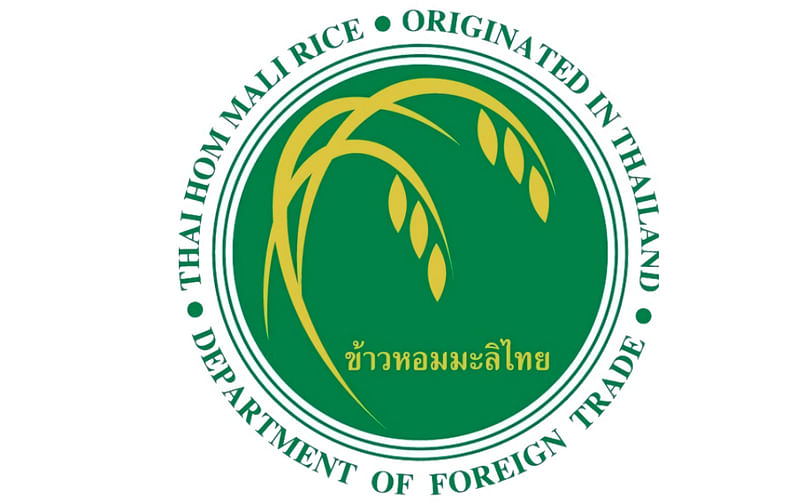 In much the same way that rice producers go through an elaborate process to get the right to use the logo of Thai Hom Mali rice certification, a stringent process has been put in place for usage of the Har Aloo quality certification by Haryana potato seed producers.
In much the same way that rice producers go through an elaborate process to get the right to use the logo of Thai Hom Mali rice certification, a stringent process has been put in place for usage of the Har Aloo quality certification by Haryana potato seed producers.
After extensive consultations with government officials, the state certification agency and seed producers, the Government of Haryana with support from the CIP team launched the Har Aloo potato seed quality certification system and finalized its logo (Figure 2).
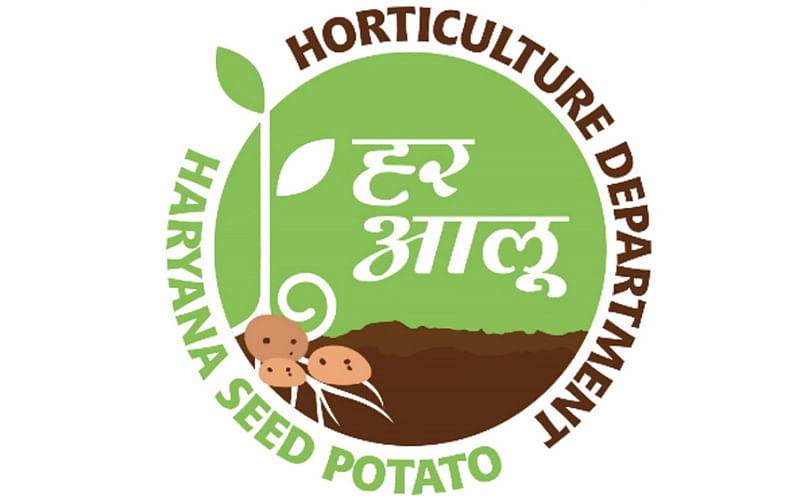 How the seed certification process works
How the seed certification process works
The first step is to identify seed producers with adequate experience, (Figure 3). These seed producers then register – either individually or as a group – with the HSSCA by paying a license fee.
They then receive hands-on training on production practices including isolation and other preventive measures to protect crops from pests and diseases. The HSSCA visits their field at specified intervals to carry out various checks (Figure 3).
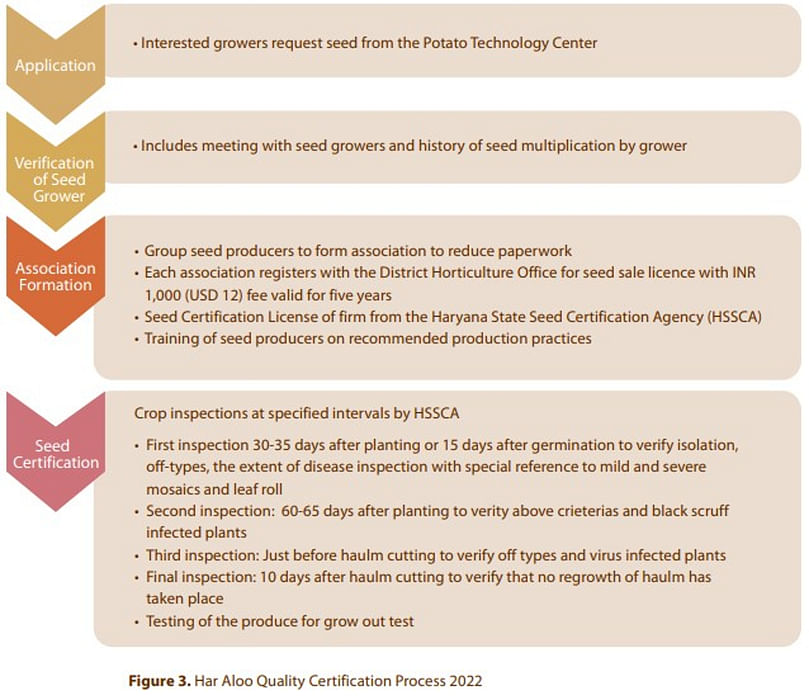 Traceability
Traceability
Parallel to the seed certification exercise, as a part of the traceability process, a digital database is being updated where all the basic crop information, such as planting, irrigation, dehaulming, and harvest is recorded.
Once the crop passes the HSSCA quality checks and is awarded certification tags, a QR code generated from this portal is awarded to the seed grower. With this, the agency approves the use of the Har Aloo quality mark on the seed bags and a QR code is placed on the bags for traceability.
Progress so far and the way forward In 2021 (the first year of the rollout of the program), twelve seed growers registered with the Har Aloo certification program. In 2022, the number increased to 55, a number which is expected to increase to 200 in 2023.
Background
When it comes to human consumption, potato is the third most important food crop in India after rice and wheat and is considered a staple crop, a vegetable crop and as cash crop.
Despite more than fivefold increase in production from 8.3. million tons in 1980 to 50 million tons in 2020 and holding the rank of second-largest producer and consumer of potato, the sector continues to struggle with several constraints, in particular, lack of affordable and available quality planting material for smallholder producers.
Potato seed production system in India
Most potato seeds in India are produced using aeroponic technology by private companies. Companies buy mother cultures from the Central Potato Research Institute (CPRI) and multiply them in tissue culture laboratories, resulting in tissue culture plantlets.
The plantlets are then placed on Styrofoam sheets in growing boxes in a high-tech temperature-controlled facility and fed with nutrient solutions which are sprayed onto their roots.
The plantlets produce mini tubers which are then harvested at regular intervals and planted in open fields by both seed companies and contracted seed-producing farmers to produce first generation (G1) seeds. Once G1 seeds are produced, further multiplication up to fifth-generation seeds takes place also in open fields, often by seed-producing farmers.
The challenge: No quality guarantee
Seed companies often purchase seeds directly from farmers who in turn purchase mini tubers which they multiply in their fields. As there is currently no central quality control monitoring mechanism for seeds multiplied by farmers, those farmers who buy them lack quality guarantees. This includes seeds labelled as early generation which may or may not actually be early generation.
At the same time, each company has its own quality control monitoring mechanism which makes the situation even more challenging when it comes to quality guarantees for farmers.
As part of its Small Farmers Large Field (SFLF) group initiative – a collective action model for improving the livelihoods of small farmers in India – CIP put this to the test, facilitating the purchase of thousands of metric tons of seeds from ‘reputable’ seed companies.
The results of CIP’s examination of the ‘Truthfully-Labelled Seeds’, as they are referred to in India, revealed several instances of poor-quality seeds, including some infected with seed borne diseases.
As potato seed costs are high and account for nearly half of the total production cost, potato farmers are reluctant to invest large sums in seed purchases without quality guarantees and end up using cheap local seeds or discarded table potatoes from the local market, which in turn, results in lower yields than those from quality seeds.
The solution: Har Aloo – a quality mark for potato
CIP, in collaboration with the Potato Technology Center, at the Department of Horticulture, Government of Haryana set out to develop a potato seed quality mark to assure quality and authenticity. The goal was to develop a system that gave farmers a degree of confidence in the quality of purchased potato seeds.
The quality mark would guarantee that the potato seed originated from Haryana and meets the quality standards defined by the Government of Haryana. After extensive deliberations with different stakeholders including government officials, Haryana State Seed Certification Agency (HSSCA), and seed producers, the Government of Haryana with support from the CIP team launched the Har Aloo potato seed quality certification system.
Har Aloo is the first of its kind for potato seeds and was developed along the same lines as the green logo of Thai Hom Mali rice (Figure 1), a stamp of authenticity from Thailand’s Department of Foreign Trade and Ministry of Commerce.

Green Logo of Thai Homa Mali Rice
After extensive consultations with government officials, the state certification agency and seed producers, the Government of Haryana with support from the CIP team launched the Har Aloo potato seed quality certification system and finalized its logo (Figure 2).

Har Aloo Logo
The first step is to identify seed producers with adequate experience, (Figure 3). These seed producers then register – either individually or as a group – with the HSSCA by paying a license fee.
They then receive hands-on training on production practices including isolation and other preventive measures to protect crops from pests and diseases. The HSSCA visits their field at specified intervals to carry out various checks (Figure 3).

Har Aloo Quality Certification Process 2022
Parallel to the seed certification exercise, as a part of the traceability process, a digital database is being updated where all the basic crop information, such as planting, irrigation, dehaulming, and harvest is recorded.
Once the crop passes the HSSCA quality checks and is awarded certification tags, a QR code generated from this portal is awarded to the seed grower. With this, the agency approves the use of the Har Aloo quality mark on the seed bags and a QR code is placed on the bags for traceability.
Progress so far and the way forward In 2021 (the first year of the rollout of the program), twelve seed growers registered with the Har Aloo certification program. In 2022, the number increased to 55, a number which is expected to increase to 200 in 2023.
Like to receive news like this by email? Join and Subscribe!
Get the latest potato industry news straight to your WhatsApp. Join the PotatoPro WhatsApp Community!
Highlighted Company
Sponsored Content
Sponsored Content
Sponsored Content
Sponsored Content






